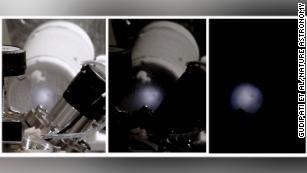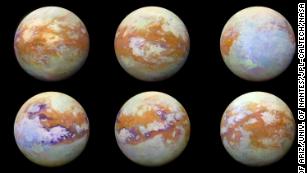THE OMEN
Just in time for Christmas, Jupiter and Saturn will come closer than they have since the Middle Ages"You'd have to go all the way back to just before dawn on March 4, 1226, to see a closer alignment between these objects visible in the night sky."
By Ashley Strickland, CNN December 3, 2020
The wonders of stargazing 03:12
(CNN)The two largest planets in our solar system are coming closer together than they have been since the Middle Ages, and it's happening just in time for Christmas.
So, there are some things to look forward to in the final month of 2020.
On the night of December 21, the winter solstice, Jupiter and Saturn will appear so closely aligned in our sky that they will look like a double planet. This close approach is called a conjunction.
"Alignments between these two planets are rather rare, occurring once every 20 years or so, but this conjunction is exceptionally rare because of how close the planets will appear to one another," said Rice University astronomer and professor of physics and astronomy Patrick Hartigan in a statement.
"You'd have to go all the way back to just before dawn on March 4, 1226, to see a closer alignment between these objects visible in the night sky."
If you're a stargazer, you've likely noticed Jupiter and Saturn have been getting closer together since the summer. And they're currently visible in our night sky, inching ever closer to one another.
But between December 16 and 25, they will become even cozier. Look for the Jupiter-Saturn conjunction low in the western sky for about an hour after sunset each evening during this time.
"On the evening of closest approach on Dec(ember) 21 they will look like a double planet, separated by only 1/5th the diameter of the full Moon," Hartigan said. "For most telescope viewers, each planet and several of their largest moons will be visible in the same field of view that evening."
While these two planets may appear close, they are still hundreds of millions of miles apart, according to NASA.
Hope for clear skies because the conjunction will be visible around the world, with the best perspective for those near the equator.
"The further north a viewer is, the less time they'll have to catch a glimpse of the conjunction before the planets sink below the horizon," Hartigan said.
The planets will be bright enough to be viewed in twilight, which may be the best time for many US viewers to observe the conjunction.
"By the time skies are fully dark in Houston, for example, the conjunction will be just 9 degrees above the horizon," Hartigan said. "Viewing that would be manageable if the weather cooperates and you have an unobstructed view to the southwest."
The best conditions to see this astronomical event will include a clear southwestern horizon and no low clouds in the distance, Hartigan said. Binoculars or a telescope may help you distinguish the planets. A telescope would enable a view of Saturn's rings and the brightest moons of both planets, he said.
If you miss this conjunction and want to see the planets with the same proximity, just higher in the sky, it won't happen until March 15, 2080 -- and then not again until after 2400.
Between 0 and 3000 CE, or Common Era, only seven conjunction were or will be closer than this one -- and two of those were too close to the sun to be seen without a telescope, according to Hartigan. So, yes, this is an incredibly rare event.
"Alignments between these two planets are rather rare, occurring once every 20 years or so, but this conjunction is exceptionally rare because of how close the planets will appear to one another," said Rice University astronomer and professor of physics and astronomy Patrick Hartigan in a statement.
"You'd have to go all the way back to just before dawn on March 4, 1226, to see a closer alignment between these objects visible in the night sky."
If you're a stargazer, you've likely noticed Jupiter and Saturn have been getting closer together since the summer. And they're currently visible in our night sky, inching ever closer to one another.
But between December 16 and 25, they will become even cozier. Look for the Jupiter-Saturn conjunction low in the western sky for about an hour after sunset each evening during this time.
"On the evening of closest approach on Dec(ember) 21 they will look like a double planet, separated by only 1/5th the diameter of the full Moon," Hartigan said. "For most telescope viewers, each planet and several of their largest moons will be visible in the same field of view that evening."
While these two planets may appear close, they are still hundreds of millions of miles apart, according to NASA.
Hope for clear skies because the conjunction will be visible around the world, with the best perspective for those near the equator.
"The further north a viewer is, the less time they'll have to catch a glimpse of the conjunction before the planets sink below the horizon," Hartigan said.
The planets will be bright enough to be viewed in twilight, which may be the best time for many US viewers to observe the conjunction.
"By the time skies are fully dark in Houston, for example, the conjunction will be just 9 degrees above the horizon," Hartigan said. "Viewing that would be manageable if the weather cooperates and you have an unobstructed view to the southwest."
If you're in New York or London, or along those latitudes, try to spot the conjunction right after sunset. Waiting an hour after the sun sets will only put the planets closer to the horizon, making them more difficult to spot.
The best conditions to see this astronomical event will include a clear southwestern horizon and no low clouds in the distance, Hartigan said. Binoculars or a telescope may help you distinguish the planets. A telescope would enable a view of Saturn's rings and the brightest moons of both planets, he said.
If you miss this conjunction and want to see the planets with the same proximity, just higher in the sky, it won't happen until March 15, 2080 -- and then not again until after 2400.
Between 0 and 3000 CE, or Common Era, only seven conjunction were or will be closer than this one -- and two of those were too close to the sun to be seen without a telescope, according to Hartigan. So, yes, this is an incredibly rare event.
Jupiter and Saturn will form the first "double planet" in 800 years

Before 2020 comes to a close, Jupiter and Saturn will be so close that they will appear to form a "double planet." The great conjunction, as the planetary alignment has come to be known, hasn't occurred in nearly 800 years.
Before 2020 comes to a close, Jupiter and Saturn will be so close that they will appear to form a "double planet." The great conjunction, as the planetary alignment has come to be known, hasn't occurred in nearly 800 years.

© Getty Images saturnjupiter.jpg
When their orbits align every 20 years, Jupiter and Saturn get extremely close to one another. This occurs because Jupiter orbits the sun every 12 years, while Saturn's orbit takes 30 years — every couple of decades, Saturn is lapped by Jupiter, according to NASA.
However, 2020's conjunction is especially rare — the planets haven't been observed this close together since medieval times, in 1226.
"Alignments between these two planets are rather rare, occurring once every 20 years or so, but this conjunction is exceptionally rare because of how close the planets will appear to one another," Rice University astronomer Patrick Hartigan said in a statement. "You'd have to go all the way back to just before dawn on March 4, 1226, to see a closer alignment between these objects visible in the night sky."
Aligning with the solstice on December 21, 2020, the two planets will be just 0.1 degrees apart — less than the diameter of a full moon, EarthSky says. The word "conjunction" is used by astronomers to describe the meeting of objects in our night sky, and the great conjunction occurs between the two largest planets in our solar system: Jupiter and Saturn.
The planets will be so close, they will appear to overlap completely, creating a rare "double planet" effect.© Provided by CBS News Jupiter and Saturn will come within 0.1 degrees of each other on December 21, 2020, during what is known as the great conjunction
When their orbits align every 20 years, Jupiter and Saturn get extremely close to one another. This occurs because Jupiter orbits the sun every 12 years, while Saturn's orbit takes 30 years — every couple of decades, Saturn is lapped by Jupiter, according to NASA.
However, 2020's conjunction is especially rare — the planets haven't been observed this close together since medieval times, in 1226.
"Alignments between these two planets are rather rare, occurring once every 20 years or so, but this conjunction is exceptionally rare because of how close the planets will appear to one another," Rice University astronomer Patrick Hartigan said in a statement. "You'd have to go all the way back to just before dawn on March 4, 1226, to see a closer alignment between these objects visible in the night sky."
Aligning with the solstice on December 21, 2020, the two planets will be just 0.1 degrees apart — less than the diameter of a full moon, EarthSky says. The word "conjunction" is used by astronomers to describe the meeting of objects in our night sky, and the great conjunction occurs between the two largest planets in our solar system: Jupiter and Saturn.
The planets will be so close, they will appear to overlap completely, creating a rare "double planet" effect.© Provided by CBS News Jupiter and Saturn will come within 0.1 degrees of each other on December 21, 2020, during what is known as the great conjunction
How to watch the great conjunction
During the last great conjunction in 2000, Jupiter and Saturn were so close to the sun that the event was difficult to observe. But skywatchers should have a clearer view of the celestial event this time around. The great conjunction will be shining bright shortly after sunset, low in the southwestern sky, as viewed from the Northern hemisphere, NASA says.
Through the entirety of December, skywatchers will easily be able to spot the two planets. For the next three weeks, you can look up each evening to watch them get closer and closer in the sky.
Jupiter currently appears brighter than any star in the sky. Saturn is slightly dimmer, but still just as bright as the brightest stars, with a recognizable golden glow.
Saturn will appear just to the east of Jupiter, and will even look as close to the planet as some of its own moons. Unlike stars, which twinkle, both planets will hold consistent brightness, easy to find on clear nights.
The event is observable from anywhere on Earth, provided the sky is clear. "The further north a viewer is, the less time they'll have to catch a glimpse of the conjunction before the planets sink below the horizon," Hartigan said.
The planets will appear extremely close for about of month, giving skywatchers plenty of time to witness the spectacular alignment throughout the holiday season. The event aligns with the December solstice, marking the shortest day of the year in the Northern hemisphere.
This will be the "greatest" great conjunction for the next 60 years, until 2080. Hartigan said that, following that conjunction, the duo won't make such a close approach until sometime after the year 2400.


No comments:
Post a Comment